August 2017 LIP of the Month
The High Arctic LIP in Canada: Stratigraphic controls and geochemical monitoring on crustal influences.
Cole G. Kingsbury 1
Richard E. Ernst 1,2
Brian Cousens 1
1 Department of Earth Sciences, Carleton University, Ottawa, Canada
2 Faculty of Geology and Geography, Tomsk State University, Tomsk,
Russia
Emails: thecgkings317@gmail.com; Richard.Ernst@ErnstGeosciences.com; BrianCousens@CUNET.CARLETON.CA
This contribution reflects additional work the first author did that relates to geochemistry component of his PhD that has not been published in (Kingsbury et al., 2016). These ideas are presented in Kingsbury et al. (2017) and are being expanded into a full paper.
- Introduction to the High Arctic LIP
The Cretaceous geology of Canada’s Arctic islands and formally adjacent regions of Norway and Russia are marked by widespread mafic magmatism. This magmatism manifests as a giant radiating dyke swarm, sills, and laterally extensive basalt flows including flood basalts. Together, these and the submarine equivalents of the Alpha-Mendeleev Ridge constitute the High Arctic Large Igneous Province (HALIP; Petrov et al., 2016; Saumur et al., 2016; Mukasa et al., 2015; Maher, 2001; Drachev and Saunders, 2006; Williamson, 1988; Oakey and Saltus, 2016; Buchan and Ernst, 2006; Jowitt et al., 2014; Fig. 1). HALIP in Canada is dominated in part by three pulses of tholeiitic magmas: two occurring at 120-130 Ma that fed basaltic lavas associated with the siliciclastic Isachsen Formation (Paterson and younger Walker Island Members) and a third pulse at ca. 95 – 100 Ma feeding lavas of the Strand Fiord Formation that are linked chemically to tabular intrusions in the South Fiord locality of Axel Heiberg Island (Fig. 2). Alkaline rocks, sometimes treated as part of HALIP, were emplaced beginning at 92 Ma with the Wootton Intrusive Complex (Trettin and Parrish, 1987; Estrada and Henjes-Kunst, 2013). In this contribution, we use a combination of stratigraphy and geochemistry to compare and contrast the geochemical evolution and stratigraphic characteristics of the earlier Isachsen Formation with the later Strand Fiord Formation.
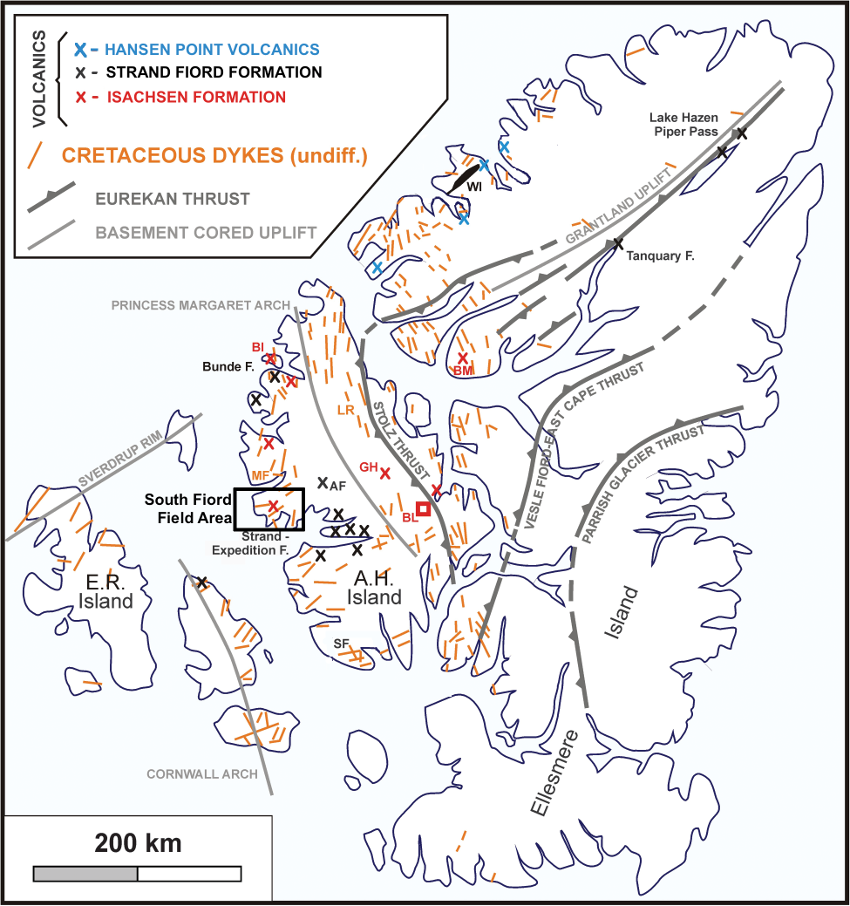
Figure 1: Map of Canada’s Queen Elizabeth Islands showing the distribution and trends of mafic dykes as well as the geographic distribution of mafic lavas in the 120 – 130 Ma Isachsen Formation, c. 95 – 100 Ma Strand Fiord Formation basalts and ca. 80-85 Ma Hansen Point Volcanics. Black box indicates location of the South Fiord field area. Figure modified from Saumur et al. (2016). Key to abbreviations: A. H. = Axel Heiberg; Bjarnason Island; BM = Blue Mountain; E.R. = Ellef Ringnes; GF = Glacier Fiord ; GH = Geodetic Hills; LR = Lightfoot River; MF = Middle Fiord and SF = Surprise Fiord.
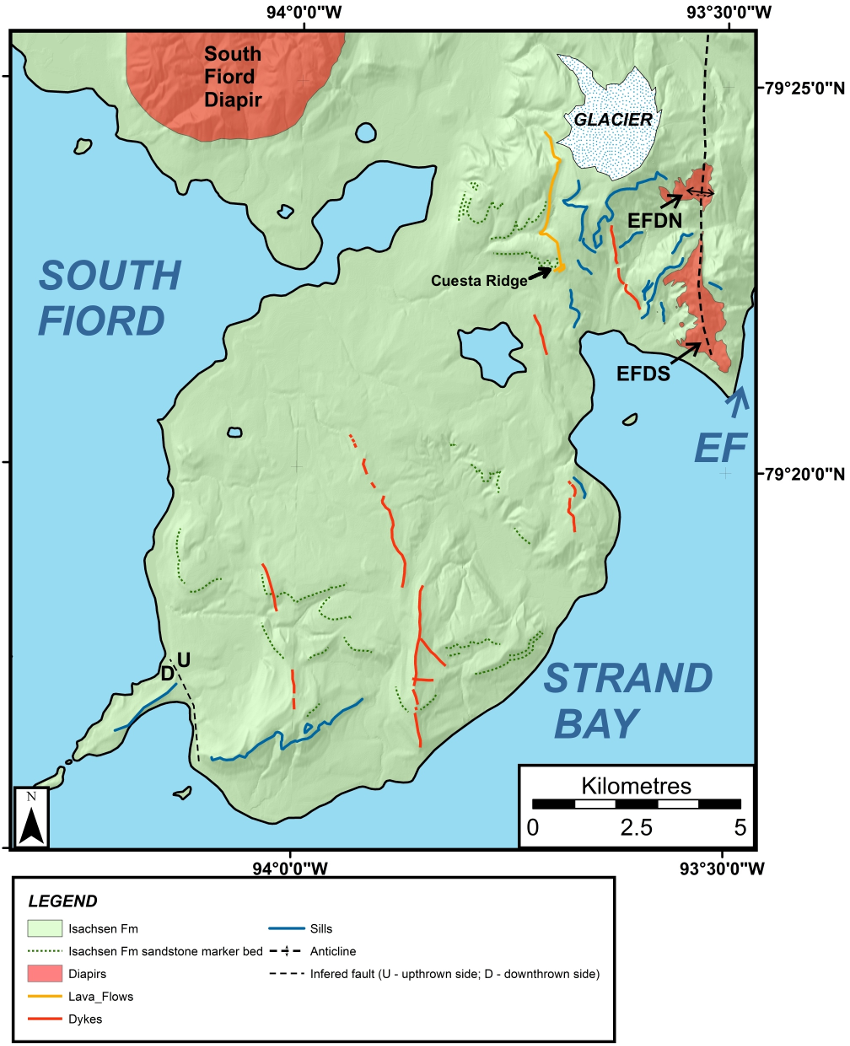
Figure 2: Geologic map of the South Fiord field area derived from SPOT-6 imagery draped on a digital elevation model (DEM). Key to abbreviation, EF = East Fiord; EFND = East Fiord North Diapir and EFSD = East Fiord South Diapir.
- Stratigraphy
Previous work done on the stratigraphy of the Strand Fiord Formation has shown that it represents a true continental flood basalt package (Ricketts et al., 1985; Williamson, 1988). These flows are laterally extensive, spanning 100s of km and rarely have interbeds of shales and sandstones separating individual flows. In contrast, stratigraphic work on the Isachsen Formation at Cuesta Ridge in South Fiord (this study; Fig. 3) as well as in other sections within Axel Heiberg Island, reveal that lava flows are commonly intercalated with up to 10s of m of sandstones and shales that separate individual flows (Williamson, 1988).
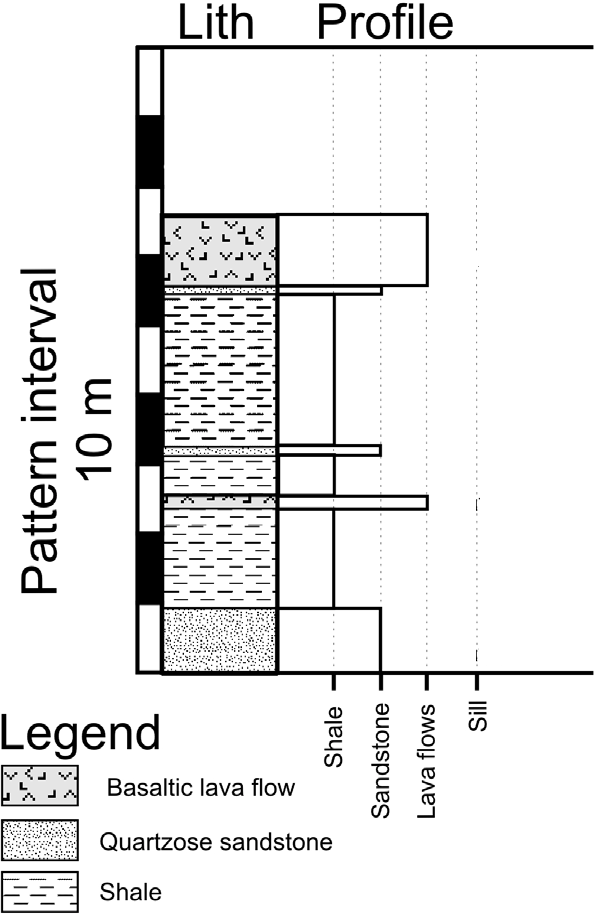
Figure 3: Measured stratigraphic profile of the Cuesta Ridge section of the South Fiord area showing lithology types.
- Geochemistry Results
Based on AFM and Nb/Y vs. Zr/Ti systematics (Fig. 4), the Isachsen Formation lavas and South Fiord intrusions, the latter which are chemically linked to the Strand Fiord Formation lavas, are subalkaline, tholeiitic basalts (Irvine and Baragar, 1971; Pearce, 2008). Mg# for Isachsen Formation lavas are 0.27 – 0.51 and 0.20 – 0.45 for the South Fiord intrusions (Fig. 5). In Ba/Nb vs. εNdt space, Isachsen Formation basalts display wide Ba/Nb ratios (~15 – 50) whereas the Ba/Nb for South Fiord intrusions tightly cluster between 15-20. South Fiord intrusions have εNdt values of+1 to +4.5, and for the Isachsen Formation flows εNdt are +2 to +6 (Figs. 5 & 6).
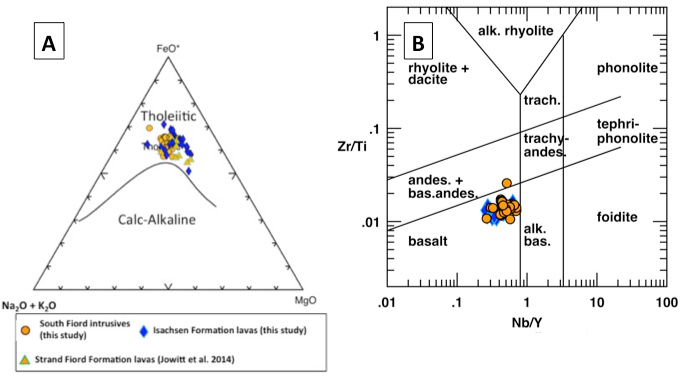
Figure 4: (A) AFM diagram (Irvine and Baragar, 1971) showing the compositional arrays between the Isachsen Formation lavas and South Fiord Intrusives of this study and Strand Fiord Formation lavas derived from Jowitt et al. (2014); (B) Nb/Yb vs. Th/Yb systematics (Pearce, 2008) between the Isachsen Formation lavas and South Fiord intrusives of this study.
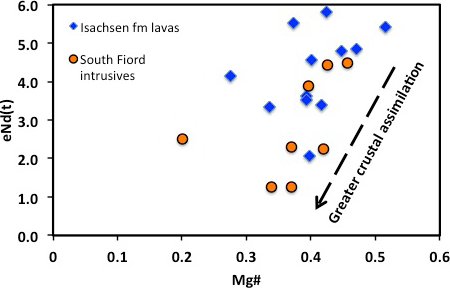
Figure 5: Mg# vs. εNdt diagram showing the compositional arrays of the South Fiord Intrusions and the Isachsen Formation lavas. Note that the Isachsen Formation lavas have generally higher εNdt values.
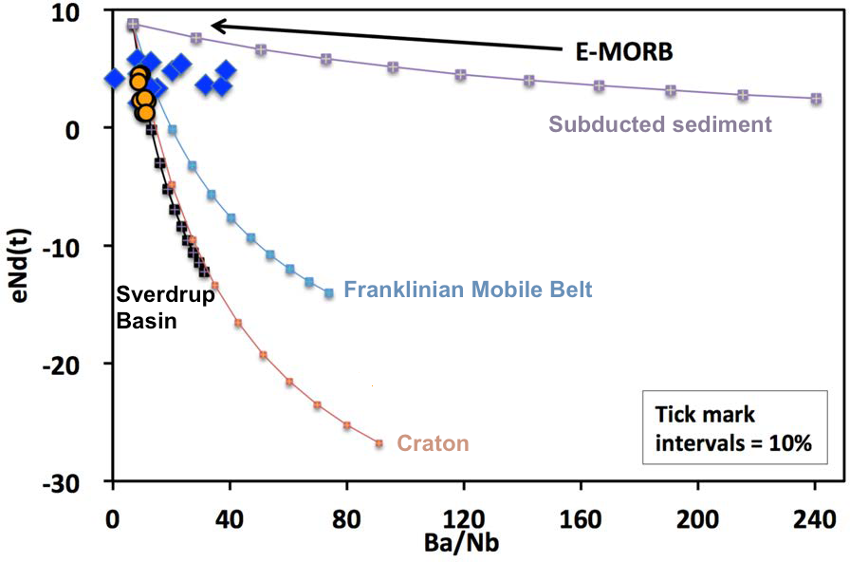
Figure 6: Ba/Nb vs. εNdt diagram showing compositional arrays of the South Fiord Intrusions and the Isachsen Formation lavas. Also shown are two-component chemical models from an E-MORB starting composition towards various components of the Arctic crust: Sverdrup Basin, Franklinian Mobile Belt and the cratonic basement. From Kingsbury et al. (2016). Models are calculated using the method found in Appendix 4 of Kingsbury (2016). Sources of compositional data: For Sverdrup Basin, Patchett et al. (2004); for the Franklinian Mobile Belt and the cratonic proxy, Patchett et al. (1999); for E-MORB, Waters et al. (2011); for subducted sediments, Plank and Langmuir (1993).
- Discussion and conclusion
The presence of sedimentary interbeds in the Isachsen Formation but the lack thereof in the Strand Fiord Formation suggest that the recurrence interval of eruptions in the Strand Fiord Formation was much greater than that of the Isachsen Formation. Chemical modeling of Ba/Nb vs. εNdt shows evidence of contamination of the Strand Fiord basalts from underlying sedimentary rocks of the Sverdrup Basin (Fig. 6), an intracratonic basin comprised of mainly sandstones and shales that reach a depth of ~13 km (Balkwill, 1978). However, the Isachsen Formation lavas are less influenced by crustal signatures.
One possible explanation for the increased level of crustal contamination in the Strand Fiord Formation is that the higher recurrence interval of eruptions produced a larger thermal anomaly in the crust that was maintained between eruptions, that then heated the sedimentary rocks of the Sverdrup Basin. Greater heating promoted crustal contamination as hotter crust is easier to act as a contaminant than colder crust. It is possible that Isachsen Formation eruptions were infrequent enough that little to no thermal anomaly was created in the crust in the aftermath of an eruptive episode and heat was quickly dissipated between eruptions. Alternatively, lavas of the Strand Fiord Formation may have erupted at higher temperatures than lavas of the Isachsen Formation, a result to be tested in the future by geochemical modeling. Finally, further work needs to be undertaken to determine whether the contamination signature that is found in the South Fiord area can also be seen at other localities across the extent of the HALIP.
Click to open/close ReferencesReferences
Balkwill, H.R., 1978, Evolution of Sverdrup Basin: AAPG Bulletin, v. 62, p. 1004–1028.
Buchan, K.L., and Ernst, R.E., 2006, Giant dyke swarms and the reconstruction of the Canadian Arctic islands , Greenland , Svalbard and Franz Josef Land, in Hanski, E., Mertanen, S., Ramo, T., and Vuollo, J. eds., Dyke Swarms - Time Markers of Crustal Evolution, Taylor & Francis, p. 27–48.
Drachev, S., and Saunders, A., 2006, The early Cretaceous Arctic LIP: its geodynamic setting and implications for Canada Basin opening, in Scott, R.A. and Thurston, D.K. eds., Proceedings of the Fourth International Conference on Arctic Margins, Anchorage, USA.
Estrada, S., and Henjes-Kunst, F., 2013, <SUP>40</SUP>Ar-<SUP>39</SUP>Ar and U-Pb dating of Cretaceous continental rift-related magmatism on the northeast Canadian Arctic margin: Zeitschrift der Deutschen Gesellschaft für Geowissenschaften, v. 164, no. 1, p. 107–130, doi: 10.1127/1860-1804/2013/0005.
Irvine, T.N., and Baragar, W.R. a., 1971, A Guide to the Chemical Classification of the Common Volcanic Rocks: Canadian Journal of Earth Sciences, v. 8, p. 523–548, doi: 10.1139/e71-055.
Jowitt, S.M., Williamson, M., and Ernst, R.E., 2014, Geochemistry of the 130 to 80 Ma Canadian High Arctic Large Igneous Province (HALIP) Event and Implications for Ni-Cu-PGE Prospectivity: Economic Geology, v. 109, no. 2, p. 281–307.
Kingsbury, C.G., 2016, Hot Rocks from Cold Places: A Field, Geochemical and Geochronological Study from the High Arctic Large Igneous Province (HALIP) at Axel Heiberg Island, Nunavut: Ph.D. thesis, Carleton University, Ottawa, Ontario, 199 p.
Kingsbury, C.G., Ernst, R.E., and Cousens, B.L., 2017, The High Arctic LIP in Canada: stratigraphic controls and geochemical monitoring on crustal influences, in Geological Society of America Abstracts with Programs, Seattle, WA.
Kingsbury, C.G., Ernst, R.E., Cousens, B.L., and Williamson, M.-C., 2016, The High Arctic LIP in Canada: Trace element and Sm-Nd Isotopic evidence for the role of mantle heterogeneity and crustal assimilation: Norwegian Journal of Geology, v. 96, no. 2.
Maher, H.D., 2001, Manifestations of the Cretaceous High Arctic Large Igneous Province in Svalbard: The Journal of Geology, v. 109, no. 1, p. 91–104, doi: 10.1086/317960.
Mukasa, S.B., Andronikov, A., Mayer, L.A., Brumley, K., Blichert-Toft, J., Petrov, O.V., and Shokalsky, S.P., 2015, Submarine basalts from the Alpha Mendeleev Ridge and Chukchi Borderland: Geochemistry of the first intraplate lavas recovered from the Arctic Ocean, in EGU Geophysical Research Abstracts,.
Oakey, G.N., and Saltus, R.W., 2016, Geophysical analysis of the Alpha–Mendeleev ridge complex: Characterization of the High Arctic Large Igneous Province: Tectonophysics, doi: 10.1016/j.tecto.2016.08.005.
Patchett, P.J., Embry, A.F., Ross, G.M., Beauchamp, B., Harrison, J.C., Mayr, U., Isachsen, C.E., Rosenberg, E.J., and Spence, G.O., 2004, Sedimentary Cover of the Canadian Shield through Mesozoic Time Reflected by Nd Isotopic and Geochemical Results for the Sverdrup Basin, Arctic Canada: The Journal of Geology, v. 112, no. 1, p. 39–57.
Patchett, P.J., Roth, M.A., Canale, B.S., de Freitas, T.A., Harrison, J.C., Embry, A.F., and Ross, G.M., 1999, Nd isotopes, geochemistry, and constraints on sources of sediments in the Franklinian mobile belt, Arctic Canada: Geological Society of America Bulletin, v. 111, no. 4, p. 578–589, doi: 10.1130/0016-7606(1999)111<0578:NIGACO>2.3.CO;2.
Pearce, J.A., 2008, Geochemical fingerprinting of oceanic basalts with applications to ophiolite classification and the search for Archean oceanic crust: Lithos, v. 100, no. 1–4, p. 14–48, doi: 10.1016/j.lithos.2007.06.016.
Petrov, O., Morozov, A., Shokalsky, S., Kashubin, S., Artemieva, I.M., Sobolev, N., Petrov, E., Ernst, R.E., Sergeev, S., and Smelror, M., 2016, Crustal structure and tectonic model of the Arctic region: Earth-Science Reviews, v. 154, p. 29–71, doi: 10.1016/j.earscirev.2015.11.013.
Plank, T., and Langmuir, C.H., 1993, Tracing trace elements from sediment input to volcanic output at subduction zones: Nature, v. 362, no. 6422, p. 739–743, doi: 10.1038/362739a0.
Ricketts, B., Osadetz, K.G., and Embry, A.F., 1985, Volcanic style in the Strand Fiord Formation (Upper Cretaceous), Axel Heiberg Island, Canadian Arctic Archipelago: Polar Research, v. 3, no. 1, p. 107–122, doi: 10.1111/j.1751-8369.1985.tb00497.x.
Saumur, B.-M., Dewing, K., and Williamson, M.-C., 2016, Architecture of the Canadian portion of the High Arctic Large Igneous Province and implications for magmatic Ni-Cu potential: Canadian Journal of Earth Sciences, v. 53, p. 528–542.
Trettin, H.P., and Parrish, R., 1987, Late Cretaceous bimodal magmatism, northern Ellesmere Island: isotopic age and origin: Canadian Journal of Earth Sciences, v. 24, p. 257–265.
Tullius, D.N., Leier, A.L., Galloway, J.M., Embry, A.F., and Pedersen, P.K., 2014, Sedimentology and stratigraphy of the Lower Cretaceous Isachsen Formation: Ellef Ringnes Island, Sverdrup Basin, Canadian Arctic Archipelago: Marine and Petroleum Geology, v. 57, p. 135–151, doi: 10.1016/j.marpetgeo.2014.05.018.
Waters, C.L., Sims, K.W.W., Perfit, M.R., Blichert-Toft, J., and Blusztajn, J., 2011, Perspective on the Genesis of E-MORB from Chemical and Isotopic Heterogeneity at 9-10 N East Pacific Rise: Journal of Petrology, v. 52, no. 3, p. 565–602, doi: 10.1093/petrology/egq091.
Williamson, M.-C., 1988, The Cretaceous igneous province of the Sverdrup Basin, Canadian Arctic: Field relations and petrochemical studies: Ph.D. thesis, Dalhousie University, Halifax, Nova Scotia, 417 p.
